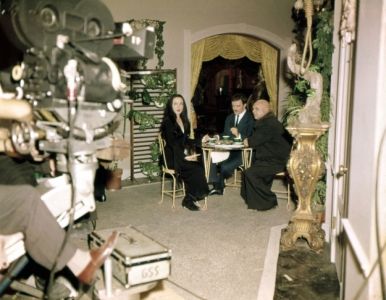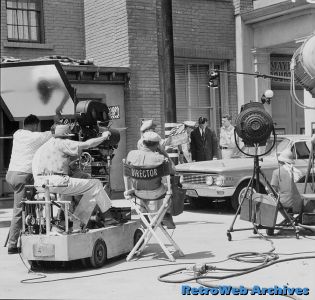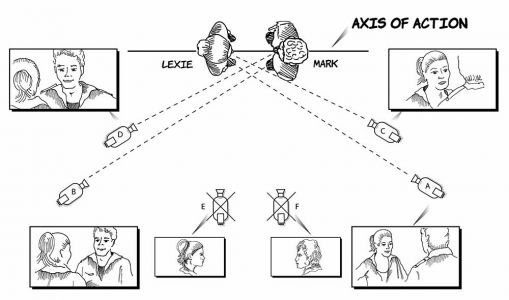Difference between revisions of "Editing: Single Camera Mode (Discussion)"
From Screenpedia
Jump to navigationJump to search| (40 intermediate revisions by 2 users not shown) | |||
| Line 1: | Line 1: | ||
| − | ''' | + | ==Single-Camera productions: Behind the scenes== |
| + | <gallery mode="packed" heights=200px> | ||
| + | File:Addams Family Still.jpg|alt=The Addams Family, circa 1960.|''The Addams Family'', circa 1965 | ||
| + | File:Andy Griffith Show street scene.jpg|alt=Promotional photograph, The Andy Griffith Show. From the episode, "Barney's Replacement," broadcast October 9, 1961.|''The Andy Griffith Show'', 10/6/1961 episode | ||
| + | </gallery> | ||
| − | + | ==Review topics from ''Television''== | |
| + | Explain these editing concepts, using a scene from ''The Sopranos''. The scene's video is on Blackboard and [http://tvcrit.org/Classes/Jbutler/BUI301/SOPRANOS_S1_D3/ screenshots from every shot are online]. You may also wish to use illustrations from [https://tvcrit.org/Classes/Jbutler/TVCrit2018_images_ByChapters/10_2020revision/index.html chapter 10]. | ||
| − | ''' Group 1 ''' | + | *'''Group 1:''' |
| − | + | **Establishing shot | |
| − | + | ***Re-establishing shot | |
| + | *'''Group 2:''' | ||
| + | **The shot-counter shot editing pattern (also known as "shot-reverse shot") | ||
| + | *'''Group 3:''' | ||
| + | **Match cut | ||
| + | ***Match-on-action | ||
| + | ***Eyeline match. There are none in this scene. What would one look like? | ||
| + | **Jump cut. There are none in this scene. What would one look like? | ||
| + | *'''Group 4:''' | ||
| + | **180° rule (see [https://vimeo.com/2690589 Peter John Ross example]) | ||
| + | ***Screen direction | ||
| + | ***How/when might this rule be broken in a TV program? | ||
| − | + | ==Decoupage exercise: #1== | |
| − | # | ||
| − | + | <gallery mode="packed" heights=200px> | |
| − | + | File:Fig10-24 GreyAnatDiagram revised 20171117.jpg|alt=Grey's Anatomy editing diagram.|Figure 10.24 ''Grey's Anatomy'' diagram. | |
| − | + | </gallery> | |
| − | + | *'''Do a sample ''decoupage''--as explained with a ''Grey's Anatomy'' scene--of a Chevrolet commercial''' (video on Blackboard and [https://tvcrit.org/Classes/Jbutler/T311/ChevCommFromTVCrit/ screenshots over here]). '''Focus ''only'' on shots 33-44 toward the end of the commercial.''' <!-- https://tvcrit.org/Classes/Jbutler/T311/ChevCommFromTVCrit/images/diagram.jpg --> | |
| − | + | **''Each student'' should start by drawing an overhead view of shots 33-44, similar to [https://tvcrit.org/Classes/Jbutler/TVCrit2018_images_ByChapters/10_2020revision/target23.html Figure 10.24], but without the frames. That is, just draw the humans and the camera positions. | |
| − | + | **Each student should be prepared to answer the following decoupage questions from the textbook (p. 272), although you may talk about them in your group: | |
| − | ''' | + | *#How is the scene’s space, the area in which the action takes place (i.e., the car), introduced to the viewer? Does an '''establishing shot''' occur at the start of the scene (or later in it)? |
| − | |||
| − | |||
| − | |||
| − | |||
| − | |||
| − | *Do a sample ''decoupage''--as explained with a ''Grey's Anatomy'' scene | ||
| − | **''Each student'' should start by drawing an overhead view similar to [ | ||
| − | **Each student should be prepared to answer the following decoupage questions from the textbook (p. | ||
| − | *#How is the scene’s space, the area in which the action takes place (i.e., the car), introduced to the viewer? Does an establishing shot occur at the start of the scene (or later in it)? | ||
*#Skip. | *#Skip. | ||
| − | *#Do these angles adhere to the 180° rule? Is screen direction maintained? If not, why is the viewer not disoriented? Or if the space is ambiguous, what narrative purpose does that serve? | + | *#Do these angles adhere to '''the 180° rule'''? Can you draw an '''axis of action'''? Is '''screen direction''' maintained? If not, why is the viewer not disoriented? Or if the space is ambiguous, what narrative purpose does that serve? |
*#Skip. | *#Skip. | ||
| − | *#Is an alternating editing pattern used? Is shot-reverse shot used? | + | *#Is an alternating editing pattern used? Is '''shot-reverse shot''' used? |
*#How does the camera relate to the character’s perspective? Are there point-of-view or subjective shots? If so, how are those shots cued or marked? That is, what tells us that they are subjective or point-of-view shots? | *#How does the camera relate to the character’s perspective? Are there point-of-view or subjective shots? If so, how are those shots cued or marked? That is, what tells us that they are subjective or point-of-view shots? | ||
| − | *#Is match-on-action used? Are there jump cuts? | + | *#Is '''match-on-action''' used? Are there '''jump cuts'''? |
*#How does the last shot of the scene bring it to a conclusion? | *#How does the last shot of the scene bring it to a conclusion? | ||
*#Skip. | *#Skip. | ||
| + | |||
| + | ==Decoupage exercise: #2== | ||
| + | |||
| + | If you finish early, do a similar analysis of a tricky scene from ''Scrubs'' (video on Blackboard and [http://tvcrit.org/Classes/Jbutler/BUI301/Scrubs_20050215/index.html screenshots over here]). Draw another diagram and work through the questions above. <!-- https://tvcrit.org/Classes/Jbutler/BUI301/Scrubs_20050215/Scrubs_20050215_diagram.jpg --> | ||
== Bibliography == | == Bibliography == | ||
| − | #Butler, Jeremy G. ''Television: | + | #Butler, Jeremy G. ''Television: Visual Storytelling and Screen Culture''. New York: Routledge, 2018. |
==External links== | ==External links== | ||
| − | #[ | + | #[https://tvcrit.org/Classes/Jbutler/TVCrit2018_images_ByChapters/10_2020revision/ ''Television'', chapter 10 illustrations] |
#[http://www.tvstylebook.com/video/ ''Television Style'' video examples] | #[http://www.tvstylebook.com/video/ ''Television Style'' video examples] | ||
| − | #[ | + | #[https://tvcrit.org/Classes/Jbutler/T311/ChevCommFromTVCrit/ Chevrolet commercial screenshots] |
| + | #[https://tvcrit.org/Classes/Jbutler/BUI301/Scrubs_20050215/ ''Scrubs'' screenshots] | ||
| + | #[https://tvcrit.org/Classes/Jbutler/BUI301/SOPRANOS_S1_D3/ ''The Sopranos'' screenshots] | ||
| + | #[https://tvcrit.org/Classes/Jbutler/T112/classicism/index.php#editing Classical Editing Examples] | ||
| − | [[Category: | + | [[Category:BUI301]] |
| − | [[Category: | + | [[Category:BUI301 Discussion]] |
| + | [[Category:JCM311]] | ||
| + | [[Category:JCM311 Discussion]] | ||
Latest revision as of 18:29, 1 October 2020
Single-Camera productions: Behind the scenes
Review topics from Television
Explain these editing concepts, using a scene from The Sopranos. The scene's video is on Blackboard and screenshots from every shot are online. You may also wish to use illustrations from chapter 10.
- Group 1:
- Establishing shot
- Re-establishing shot
- Establishing shot
- Group 2:
- The shot-counter shot editing pattern (also known as "shot-reverse shot")
- Group 3:
- Match cut
- Match-on-action
- Eyeline match. There are none in this scene. What would one look like?
- Jump cut. There are none in this scene. What would one look like?
- Match cut
- Group 4:
- 180° rule (see Peter John Ross example)
- Screen direction
- How/when might this rule be broken in a TV program?
- 180° rule (see Peter John Ross example)
Decoupage exercise: #1
- Do a sample decoupage--as explained with a Grey's Anatomy scene--of a Chevrolet commercial (video on Blackboard and screenshots over here). Focus only on shots 33-44 toward the end of the commercial.
- Each student should start by drawing an overhead view of shots 33-44, similar to Figure 10.24, but without the frames. That is, just draw the humans and the camera positions.
- Each student should be prepared to answer the following decoupage questions from the textbook (p. 272), although you may talk about them in your group:
- How is the scene’s space, the area in which the action takes place (i.e., the car), introduced to the viewer? Does an establishing shot occur at the start of the scene (or later in it)?
- Skip.
- Do these angles adhere to the 180° rule? Can you draw an axis of action? Is screen direction maintained? If not, why is the viewer not disoriented? Or if the space is ambiguous, what narrative purpose does that serve?
- Skip.
- Is an alternating editing pattern used? Is shot-reverse shot used?
- How does the camera relate to the character’s perspective? Are there point-of-view or subjective shots? If so, how are those shots cued or marked? That is, what tells us that they are subjective or point-of-view shots?
- Is match-on-action used? Are there jump cuts?
- How does the last shot of the scene bring it to a conclusion?
- Skip.
Decoupage exercise: #2
If you finish early, do a similar analysis of a tricky scene from Scrubs (video on Blackboard and screenshots over here). Draw another diagram and work through the questions above.
Bibliography
- Butler, Jeremy G. Television: Visual Storytelling and Screen Culture. New York: Routledge, 2018.


